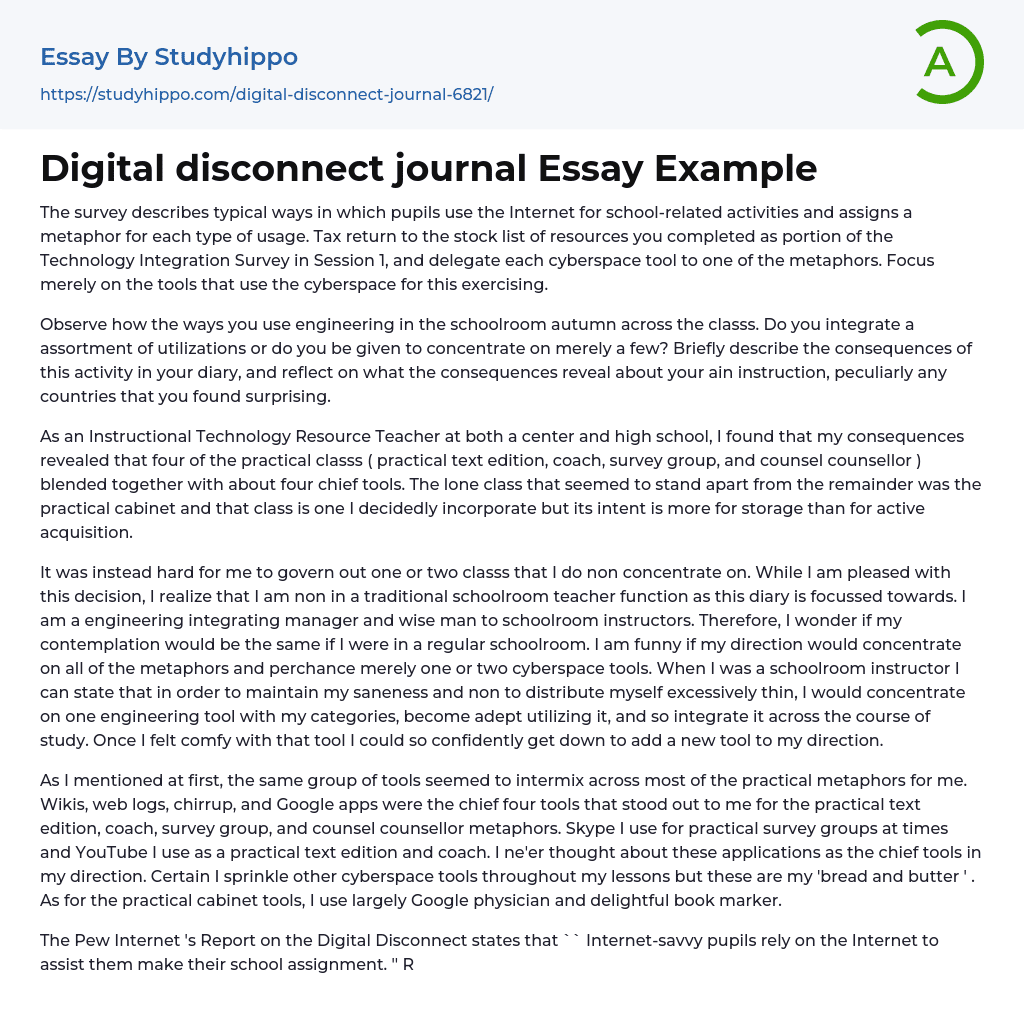The survey classifies how students utilize the Internet for school-related tasks and assigns a metaphor to each type of usage. Please refer to the stock list of resources you completed in Session 1 of the Technology Integration Survey and assign each internet tool to one of the metaphors. Focus solely on the tools that use the internet for this exercise. Take note of how your technology usage varies across different subjects. Do you use a variety of applications or do you primarily focus on just a few? Briefly explain the results in your journal, reflecting on what they reveal about your teaching style, particularly any surprising areas. As an Instructional Technology Resource Teacher at both middle and high schools, I found that four practical categories (virtual textbook, coach, study group, and guidance counselor) merged with a
...round four main tools. The only category that stood out from the rest was virtual cabinet, which I do incorporate but mainly for storage purposes rather than active learning. It was quite difficult for me to exclude one or two categories that I don't prioritize in my teaching approach.While I am content with this conclusion, I acknowledge that my role differs from that of a traditional classroom teacher, as this journal specifically focuses on that role. As an engineering integration manager and experienced classroom instructor, I question if my approach would be the same in a regular classroom setting. Would I prioritize all metaphors or just one or two internet tools? When I taught in the classroom, I would focus on mastering one technology tool with my students and then integrate it into the curriculum. Once I felt comfortable wit
that tool, I could confidently introduce a new one into my instruction. Similarly, these same set of tools seemed to work well across most practical scenarios for me. Wikis, web logs, Twitter, and Google apps were the main four tools that stood out to me for textbooks, coaching, study groups, and counseling purposes. Occasionally, Skype was used for virtual study groups and YouTube for virtual textbooks and coaching sessions. While these applications were not initially at the forefront of my teaching practice, they have now become indispensable. Although I do incorporate other internet tools into my lessons as well, these particular ones play a central role in how I approach teaching. In terms of organization, Google Docs is primarily utilized along with a delightful bookmark tool.The Digital Disconnect report from Pew Internet reveals that students who are knowledgeable about the internet heavily depend on it for their assignments. Upon reflecting on this study, I have realized that my focus should be more on integrating new technology tools for students who are not as familiar with the internet, rather than those who already are. These particular students lack internet access at home and do not explore or experiment with various web 2.0 tools. Unfortunately, in many districts, students who have below-average technology skills tend to fall behind. Typically, students with average or above-average skill levels are left to work independently or learn from their peers. This aligns with last week's findings from Pew Report on Teens and Social Media which demonstrated that teenagers' online experiences often involve peer mentoring instead of face-to-face interactions. This supports the current week's findings from Pew Report that state "Internet-savvy students
come to school with different expectations, skills, and access to resources."
- Academia essays
- Higher Education essays
- Language Learning essays
- Studying Business essays
- Education System essays
- Study essays
- First Day of School essays
- Scholarship essays
- Pedagogy essays
- Curriculum essays
- Coursework essays
- Studying Abroad essays
- Philosophy of Education essays
- Purpose of Education essays
- Brainstorming essays
- Educational Goals essays
- Importance Of College Education essays
- Brown V Board of Education essays
- The Importance Of Higher Education essays
- Online Education Vs Traditional Education essays
- Academic And Career Goals essays
- Academic Integrity essays
- Brown Vs Board Of Education essays
- Distance learning essays
- Technology in Education essays
- Vocabulary essays
- Writing Experience essays
- Importance of Education essays
- Early Childhood Education essays
- Academic Degree essays
- Academic Dishonesty essays
- School Uniform essays
- Academic writing essays
- Cheating essays
- Bachelor's Degree essays
- MBA essays
- College Life essays
- Grade essays
- Diploma essays
- Phonology essays
- Sentence essays
- Filipino Language essays
- Pragmatics essays
- Millennium Development Goals essays
- History Of Education essays
- Graduate School essays
- Middle School essays
- School essays
- Special Education essays
- University essays




